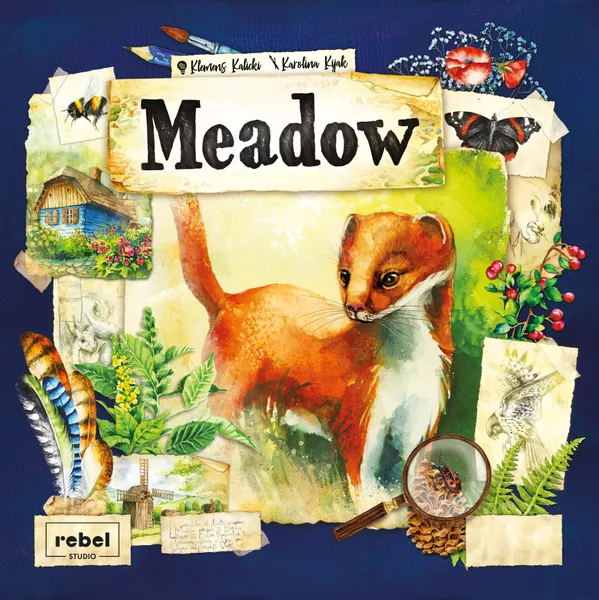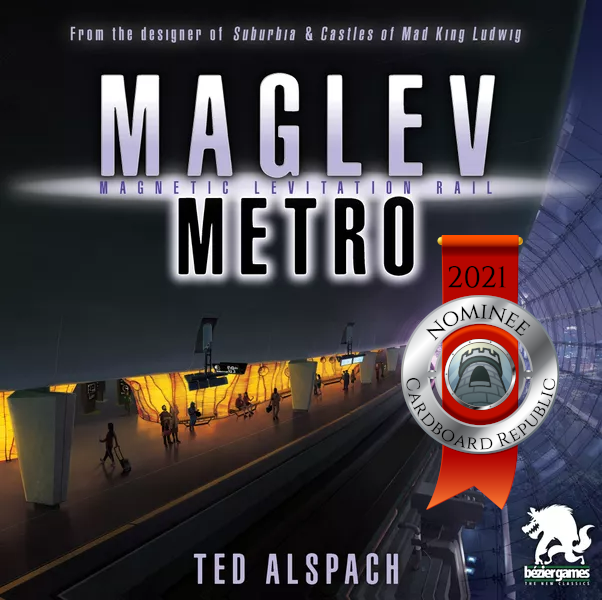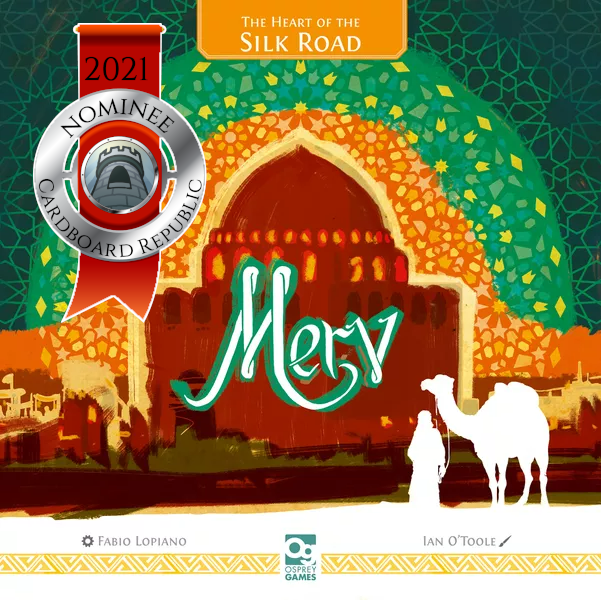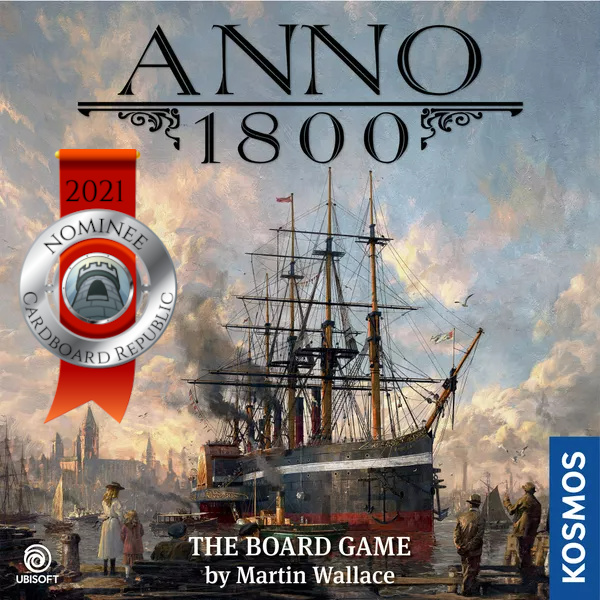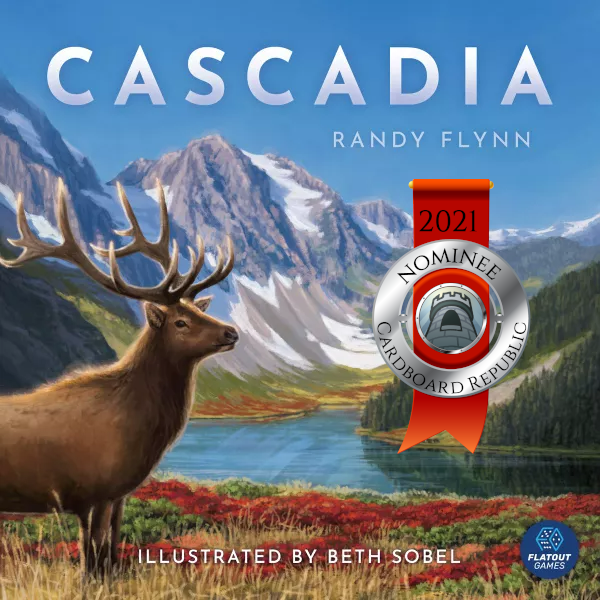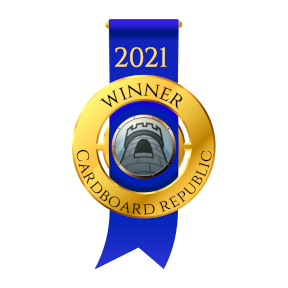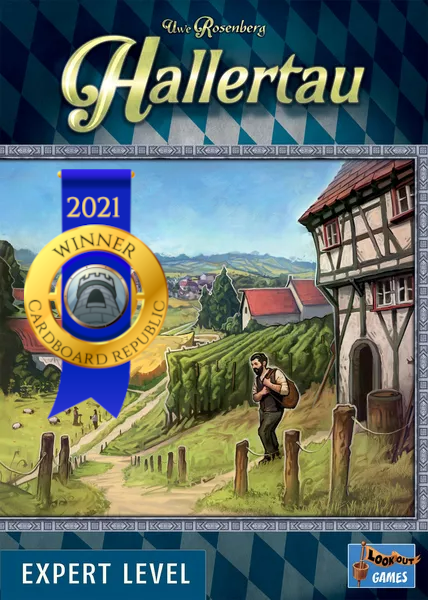The Cardboard Republic has rolled out the annual Laurels of the Republic awards, celebrating the best new games released in 2021 for each of the gamer archetypes. What follows are the finalists for one of those groups.
 Whether it’s amassing the largest armies, hoarding the most gold, or building the best village, Architects are always on the lookout to expand their sphere of influence as much as possible. These world builders thrive on games where they feel the game has a point and that the best way to secure victory has more options than simply cracking skulls. Careful, methodical, and always looking to trade short term goals for long term opportunities, games of this nature reward strategy, persistence, and a sense of progression more than anything else.
Whether it’s amassing the largest armies, hoarding the most gold, or building the best village, Architects are always on the lookout to expand their sphere of influence as much as possible. These world builders thrive on games where they feel the game has a point and that the best way to secure victory has more options than simply cracking skulls. Careful, methodical, and always looking to trade short term goals for long term opportunities, games of this nature reward strategy, persistence, and a sense of progression more than anything else.
And with that, here are The 2021 Laurel Finalists for Architects:
Honorable Mention: Meadow
Publisher: Rebel Studio / Asmodee North America | Players: 1-4| Play Time: 60-90 Minutes
Of all the overarching factors into what Architects yearn for most in a game, the single greatest attribute tying them all together – more than any theme, mechanic, or level of complexity – is a definitive sense of progression. Whether it’s leveling up some new skill, exploring territory in an alien world, or laying the final rivets on a skyscraper, the notion that what you’re developing, the object of your considerable efforts to improve, is being done with meaningful purpose.
Especially if doing so is advantageous to you.
At times this tends to be equated way with a game’s depth, as longer, more involved games generally provide the headroom to embrace and properly facilitate that desired sentiment. However, this is far from universal. Well-designed, well-executed lighter games are more than capable of generating that same level of adulation. One of two such titles here today is the estimable card-driven, tableau-based set collector, Meadow.
Fittingly released during the summer of 2021, Meadow transports players to a bucolic country landscape with the express – indeed sole – purpose of compiling evidence that you are the most adept nature observer in the area. This is done by way of drafting cards from a central grid matrix of available cards and adding them to your personalized Thomas Cole painting in the making. Most cards in the game consist of observable animal habitats, animal species themselves, or scenic wilderness landscapes, all of which have varying point values and are conveyed through dozens of eye-catching watercolor illustrations. In the end, you want to have the most valuable tableau among your little nature troupe.
In a bit of irony, however, where Meadow flourishes most is in how it limits your ability to precisely accomplish that.
While terrain cards are freely added, they are but the substrate to your evolving picture. Every other card contains prerequisites, either referencing the needs for specific terrains or the right combinations of visible cards in your tableau with the desired iconography. The hitch is that new cards must cover one of the cards that permitted it to be played in the first place (usually with a subtle thematic association), creating a continually shifting spate of icons as your tableau columns gradually fill up with lovely, scenic card towers.
Meadow’s gameplay appeal is therefore less about engine building or extensive planning as it is about deftly using the cards available to you in the most lucrative and efficient way possible. Effectively stringing available cards together is as valuable as it is visibly satisfying, rewarding you on both fronts. Meadow is accessible, straightforward, and visually striking. Indeed it doesn’t take much observation to understand how it scratches an Architect’s need for growth a very organic way.
The Nominees
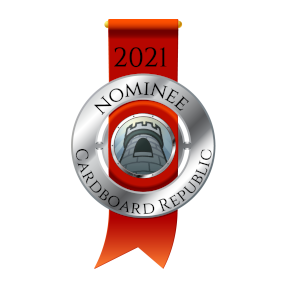
Number Five: Maglev Metro
Publisher: Bezier Games | Players: 1-4 | Play Time: 60-90 Minutes
Taking place in a more idealized near-future, Maglev Metro envisions a world championing the use of clean, cheap, high speed public transportation. As part of that mission new works projects have been introduced, with each player being competing rail tycoons looking to refurbish aging city subways with those that run on magnetic levitation (“maglev”) systems. Maglevs, long hailed as a next frontier of rail travel have consistently demonstrated their capabilities as faster, quieter, and all around more efficient solutions befitting a greener vision of the world.
Sigh. If only.
Nevertheless, this colorful pick-up-and-deliver rail game begins on one of two possible maps, Manhattan, or Berlin, each of which slightly alters the complexity and length of gameplay. (Additional maps have just recently been announced as of this publication.) Throughout its variable runtime, each player takes turns performing just 2 of 9 possible actions in whatever combination seen fit in the moment. Nearly all of these actions correlate in some form to picking up, transporting, or dropping off rail passengers, though one vital action also ties into one of the game’s most visually captivating elements: laying track. Tracks in Maglev Metro are transparently layered such that player routes can overlap without blocking one another while organically generating a pleasing subway-style route map over time.
Additionally constraining your efforts, however, is that the strength of your actions are directly tied to the number of passengers you deliver to their desired stations (and onto your player board). At the outset your only fares are the region’s trio of dutiful robot worker types who strengthen the efficacy of your turns and, eventually, unlock access to four additional slates of human passengers. Getting these human professionals to their intended termini in turn is the chief method of scoring points in the game while also serving as the endgame trigger.
There are unquestionably a lot of moving pieces in Maglev Metro (literally and figuratively) that factor into your tactical decisions. Yet while advanced planning is often a necessity, Maglev Metro particularly flourishes in the space of continuous incremental improvement. Although navigating a litany of desired but fluctuating rolling objectives are how you ultimately reach Endgame Station, this truly is a game that relishes in the how of how you get there. Namely, by finding ways to continually upgrade, modify, and optimize your actions – nearly all of which are about moving passengers from one location to another.
For Architects, its progressively improving personal board states, alongside a slowly unfolding player-generated map, creates an irresistible feedback loop that both requires and rewards expansion and growth. Float in a visually appealing theme and ample replayability over that, and Maglev Metro is a game bound to get some frequent ridership.
Number Four: Merv: The Heart of the Silk Road
Publisher: Osprey Games | Players: 1-4 | Play Time: 75-90 Minutes
Every award cycle we invariably end up with at least one game which straddles the line of eligibility. Typically these are games that had surprise street dates or crowdfunding fulfilment in the final week or two the previous December.
And then there was Merv.
Officially Merv’s North American arrival was in November 2020, which should have clearly put it in last year’s running. Except 2020 was the year in which absolutely nothing made sense or went to plan, and a mere trickle of the print run arrived ashore due to Freightageddon, with the overwhelming majority not appearing until several months into 2021. Only then could most consumers obtain it.
With such extreme (but all too common) supply chain circumstances of the last 18 months, we made the decision to call Merv a de facto 2021 US release based on when most of it entered distribution. Its final status here is even more indicative that letting it fall by the wayside over an uncontrollable technicality would’ve been an injustice in general – let alone for fans of city-building and resource management.
Merv, as the name cleverly alludes to, is based on the former Central Asian city at its height of grandeur during the early 13th century – just prior to being utterly devastated by a Mongol invasion. Over a scant four turns in each of its three rounds, your objective is to build up power and prestige within the city while also taking steps to limit the impact of the incoming Mongol threat.
Turns in Merv revolve around its gridded city center tiles. Each turn you select an unchosen space along that side of the grid and choose a tile in its corresponding row or column. Tile choice is pivotal to your influence peddling efforts, for in addition to potentially claiming ownership of it and using it generate resources, its listed action specifies which of the game’s half dozen locations you visit that turn. Locations mechanically vary in function and style, such as spending time in the mosque, establishing trade routes, or erecting walls around the tile perimeter to guard agai the Mongol horde, yet each contributes a path to VP-fueled glory.
This variety also strategically and thematically undergirds Merv’s appreciable sense of progression and advancement, which isn’t guaranteed in an abstracted midweight Euro. To Architects, this expression of purpose is paramount – they want to know what they’re doing has a concrete point. Merv commendably delivers such an experience. From the rise of the inner city to potent rewards for more deeply committing to specific areas, there’s a palpable sense of development which guides the sentiment that you’re continuously building towards something in a deliberative way.
At least until Tolui Khan shows up…
Number Three: Anno 1800
Publisher: Thames & Kosmos | Players: 2-4 | Play Time: 120 Minutes
In the mid 1980s, a revolutionary new computer game was being pitched around to various companies with little success. This game focused less on the traditional win/lose model and instead touted a sandbox style game of urban planning and economic management.
Publishers were initially wary on the idea, fearful that such a game wouldn’t be successful. But by the end of the decade those fears inevitably proved wildly unfounded. Because the game in question – SimCity – would quickly go on to become a dominant force in PC gaming through the new millennium, spawning extensive spinoffs, new franchises, and serving as indelible proof that there was indeed an audience for economic simulation video games.
Among those who jumped at this new genre opportunity were the folks behind the now decades-long Anno series. The latest of which, the industrial age themed Anno 1800, is now also an industrial age board game.
Although significantly pared down from its namesake, Anno nevertheless remains a compelling economic development game that’s as challenging as it is rewarding. Your task in Anno is to guide and cultivate the path of industrial progress of your own island nation by building new goods factories, recruiting and upgrading workers, expanding into new territory, and ultimately trying to be the first player to completely fulfil the diverse wants of your population – depicted via a hand of playable cards that make up the bulk of your scoring potential.
At first, Anno appears to be your part and parcel tech tree game. Buy X to craft Y, upgrade Y to build Z, that sort of thing. But in actuality Anno 1800 is a tech web, with layers of clever tile laying and trade mechanics meshed in. The core mechanic of the game is still purchasing one factory type to advance towards another, but players have to contend with limited pools of workers, limited viable building locations, and opponents who have every right to leverage trade abilities to gain access to each other’s upgrades. Players must therefore be creative with their strategies by balancing their own technological aspirations with finding ways to capitalize on what your opponent may need to do the same.
Success in this weighty economic-themed title takes time and effort to fully come to fruition, a bevy of small calculations that slowly bring you to an inflection point where your people’s demands for goods forces you to shift from mere raw growth into refinement. Both flexibility and planning fuel Anno 1800, all in the name of advancing an agenda of your own making. To Architects, this celebratory microcosm of technological progress is every bit their kind of industrial blueprint, and they’re more than willing to see where it takes them.
Number Two: Cascadia
Publisher: Flatout Games / Alderac Entertainment Group | Players: 1-4 | Play Time: 30-45 Minutes
If you were even remotely plugged in to the board game zeitgeist in 2021, it’s almost impossible that you haven’t heard about Cascadia. Whether you’ve seen it, heard it, played it, bought it, or been in earshot of someone else who has done one of those things, its presence was neigh inescapable. It was one of the biggest hits of the year in terms of fandom, hype, critical acclaim, and sales, with AEG selling out of at least two decent sized print runs in its comparatively short time in the wild. All of which leads to the natural question: was all that popularity justified?
To which we can safely say, largely yes.
Part of Cascadia’s fervent appeal is undoubtedly due to the Flatout Games team quickly having established themselves in a few short years for their knack of creating lightweight titles that delicately balance low-complexity rules with meaningful player choices in a visually interesting way. The result being games that are easy to teach, easy to learn, easy to look at, and yet retain a high degree of replayability. This was a huge component to the ardor around Flatout’s similar 2020 tile-laying hit, Calico. They’ve repeated that formula once again with Cascadia, arguably, to an even greater success.
Part of it also may have to do that Cascadia serves well as a de facto nature brochure for the Pacific Northwest.
Procedurally Cascadia is both straightforward and unfettered. In this scenic abstract tile-laying game, players are attempting to build out a lively and harmonious regional ecosystem. Players take turns drafting a pair of terrain and animal tiles that are added to your tableau. Terrain tiles are comprised of one or more terrain types and one or more animal symbols, denoting possible animal habitats. These may be added to any adjacent tile. Animal tiles are placed onto any terrain tile without an existing animal tile that shares its symbol. Repeat until the terrain deck is empty.
Where Cascadia thrives, however, is that this series of rudimentary choices is entirely in pursuit of its endgame. Not only do you gain VP for consecutive terrain tiles, but each animal type scores differently based on criterion cards randomly determined during setup. The outcome is an easily approachable, highly replayable game with a delightfully puzzle-laden core. Its focused, if basic, actions reward you with an appreciable sense of progress as your region expands according to your intentions. That it’s on the lighter end of games that Architects particularly flock to only highlights its quality experience even further. Indeed, for this group its well-tailored combination of process, progress, and purpose ensures that Cascadia is precisely the kind of game they – and others – will understandably fawn over.
Even with its lighter footprint, Cascadia made a heavy run for this year’s top spot, and despite significant competition it wasn’t without possibility of happening. In the end, though, that honor went to…
The Winner
2021 Architect Laurel – Hallertau
Publisher: Lookout Games | Players: 1-4 | Play Time: 50-140 Minutes
Look, there shouldn’t be any shock to see Hallertau here. Prolific designer Uwe Rosenberg is essentially the Stephen King of game design: you roughly know what you’re in store for, and most of it is set in Maine. Or in Uwe’s case, it’s either new takes on tile placement or complex building games with a strong focus on economic engines – usually set in rural Germany or Scandinavia. Hallertau is very much the latter.
That his designs are a known quantity is hardly a negative, however. If anything, the fact that someone can routinely construct new and often novel mechanistic approaches to the same concept, effectively reinventing different solutions to the same puzzle over and over, is nothing short of prodigious. It should be lauded.
Hallertau focuses on the rural Bavarian region of the same name, circa 1850, right as the region’s status began its ascent due to its cultivation of beer-making ingredients. A beer-centric game this is not though. Instead, each player is the head of a local village seeking grow and develop their hamlet into something grander.
Over six rounds of hardscrabble work, players compete via a modified form of worker placement to take a variety of actions which assist you in amassing or converting specific goods, sowing and harvesting fields, and breeding sheep, all with the intent of having a critical mass of provisions to spend on upgrading your town’s buildings.
Accomplishing this is no easy feat, as Hallertau encompasses nearly a dozen resource types, including four different crops, and all of them are needed in some form as the game advances. Aiding you is a slate of usable cards, each of which reward you with points and/or goods…assuming you have or can spare the necessary requirements.
Oh, and the cost to upgrade buildings increases every round.
The crescendo to each round involves expending all these gains on your town, reflected in typical Rosenberg flair through a novel visual medium: each time a building is upgraded it slides one space to the right. When every building is upgraded once, the center building tile itself shifts, bestowing additional workers for future rounds, and eventually, massive endgame VP.
Suffice it to say, prudent resource management and thinking ahead are essential ingredients to success in Hallertau. Yet an appreciable byproduct is the sense your town is progressing incrementally, reinforced through tactile board changes and a solid air of accomplishment from your hard work. For Architects, this an ideal game where both its intoxicating challenge and entire premise, its mise-en-scène, is about directly controlling measured, methodical expansion and rustic growth. All in all making it precisely the kind of game they’re eager to raise a pint of bitter to. And why it, in turn, has rightfully harvested this year’s top spot.
![]()
Hallertau Contest!
Naturally we thought about different ways to highlight how expansive and rewarding the winning title of this year’s Architect Laurel is. Given how much of the game was indirectly inspired by the region it’s named for and its claim to fame as a renown locale for top-notch beer ingredients, an initial thought was of course to do something similar and fly a lucky few out to Bavaria so they could get a firsthand experience of the thrilling life of a barley farmer. When that didn’t pan out due to issues of cost, international logistics, cost, ongoing COVID restrictions, cost, and the small matter of the German Ministry of Food and Agriculture saying what we were attempting was dangerously closed to forced labor, we had to scrap it.
We then pivoted to a different celebratory approach: the Farm Saga, a marathon Uwe Rosenberg session where players must play every one of his crunchy Euro titles back to back, and we would chain the achievements of one game into the next. We were particularly excited about that one, but ultimately had to abandon the trial run after just four games due to what the local hospital staff later called “an unhealthy obsession with horticulture and dangerous amount of ennui trigged by everyday circular objects”. Whatever.
In the end due to time limits (and to avoid another letter from the AMA), we decided to ditch all of those ideas entirely and just focus on the game by raffling off a copy instead.
Anyway, let’s get to it!
That’s right! Enter below for your chance at your very own copy of Hallertau!
Note: In honor of their award recognition, Asmodee North America has kindly provided a copy of this game for giveaway purposes.
![]()
Be sure to check out the 2021 Laurel Award pages for the other archetypes once they go live!

